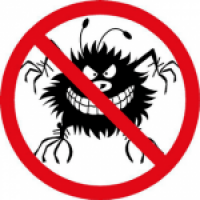Malware Prevention
For the most part, malware seems to slip by many, if not all anti-virus products. I have had machines brought to me with AVG, Avira, McAfee, Norton, Kasperski, etc that have been infected with malware
and are affected with the associated registry changes and damages.
So what gives? Aren’t we protected if we have an updated anti-virus installed?
Obviously not.
I remove a lot of malware and have learned malware patterns and where their damages lie. I know how malware infections happen and I know how to avoid them. I also know a secret that the major anti-virus companies don’t want you to know – actual viruses are very rare and the biggest modern threat is malware. The kicker is that their products will not stop malware from being installed.
So what about protection?
The best protection is our brain. There are conscious things we can do to prevent malware from becoming installed. Become aware. Look out fortraps and tripwires because they’re everywhere. If something pops up saying “you may be infected”, question it before you click OK, REPAIR or FIX. Is it really your system or your computer’s anti-virus warning you or is it a script trying to scare you into clicking a button that will cause the installation of malware and the associated damages?
Trying to watch an embedded video but the page prompts you to install a “missing codec” by clicking a button? Surfing the web and a generic pop-up tells you to click the button to update JAVA? I think not. If you go for it, you might be calling me. Today’s malware is designed with effective social-engineering and you are tricked into installing it yourself. That’s one reason why most anti-virus applications are ineffective against this type of malware.
One thing is certain – once being tricked into installing malware on your own system, there is nothing on those pop-ups that you can click on that will cause them to go away. Depending on the type, further interaction with these pop-ups can cause deeper damage and the installation of harder-to-detect root-kits.
Here’s what I am telling my customers:
If you are on the Internet and a Windows alert pops up with a warning or an unfamiliar scan window is activated that is telling you that you have numerous infections, assume that it is a trick unless you can confirm that this message is actually from your anti-virus. Adobe and JAVA updates are offered when Windows loads – NOT while surfing the web. When you determine that a pop-up is likely a tripwire, close it and all other occurrences of your web browser by opening Task Manager (right-click on the clock and choose Task Manager) and then “End Task” everything listed in the Applications tab.
Don’t click OK or even the “X” on the initial pop-up. Close everything on your screen with Task Manager including the web page you were on and then don’t go back there again. If Task Manager won’t open, then it’s too late and you are already infected. Please stop everything and consider calling me right away. Much better removal removal results happen on fresh infections rather than when someone has been futilely hacking at it with an axe for a few days.
On my customers’ computers, I am installing a malware preventative application but as I mentioned earlier, no application I’ve seen so far can save us from ourselves.
Remember – don’t fall for the “missing codec” trick in order to watch Lady GaGa’s newest video but if you do get infected with malware and are in my service area, you know who to call.

